
Originally published in The Clarinet 49/4 (September 2022).
Printed copies of The Clarinet are available for ICA members.
A Panorama of Clarinet History
Andrea Greganti and His Clarinet Collection
by Luca Saracca
Italian Version can be found here
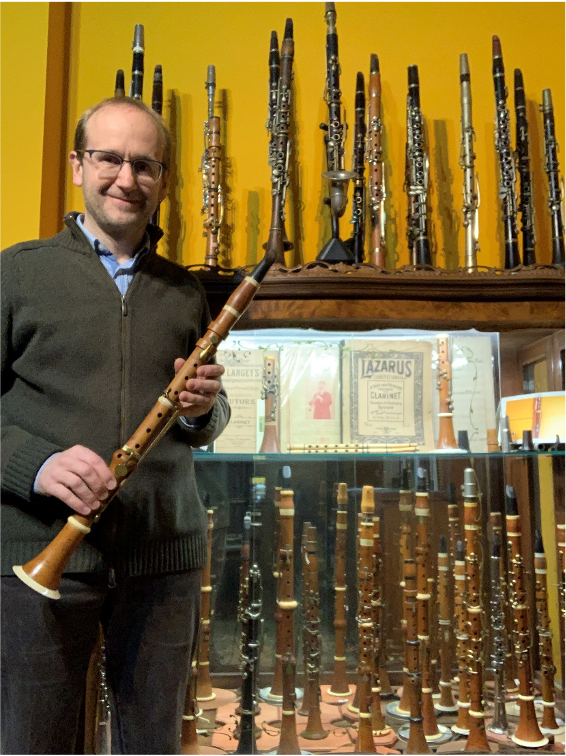
Andrea Greganti and his clarinets
Thanks to the designation of the Italian Clarinet Academy as a Partner Organization of the International Clarinet Association, I was able to find and reconnect with many friends, colleagues and former students I lost sight of over the years. With great pleasure I returned to meet along the Adriatic coast – between the Velvet Beach of Senigallia and the Conero Riviera – Andrea Greganti, clarinetist, clarinet teacher at the Ferraris Comprehensive Institute of Falconara Marittima and director of various musical bands including the Youth Band of the Marche.
Andrea, my student at the Gioachino Rossini Conservatory in Pesaro, was in 2006 the first in the history of that institute to achieve the II level Academic Diploma in Clarinet with a specialization in contemporary music. Before this, of course, he had already obtained a conservatory diploma, again at the Rossini Conservatory, in the early ’90s and subsequently graduated from the DAMS (Drama, Art and Music Studies) at the University of Bologna in music disciplines. He has had a multifaceted career, always characterized by various interests, both as a student and researcher, concert artist and teacher, without neglecting the compositional aspect and love for direction. The names of the professors with whom he has deepened his musical knowledge are many, as well as those of the musicians with whom he collaborated; among these stands out for continuity that of William Overton Smith. Andrea, after having attended Bill Smith’s clarinet master classes at the ARAM in Rome in 1997, interviewed him for his thesis at DAMS and in 1999 he was called to play with him and with the SISMA Eclettico Ensemble group on a tour of Italian concerts. Moreover, in July 2000, Greganti performed the complete pieces for solo clarinet written up to that date by William O. Smith in the event “A protagonist among us, homage to William O. Smith” organized by the Valentino Bucchi Foundation as part of the 2000 Jubilee Festival. Now, keeping faith with his kaleidoscopic musical personality, I find him as a clarinet collector.
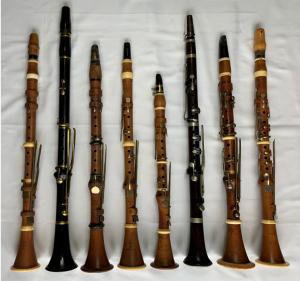
Photo 1: 1800s clarinets. From left: Astor in C with 5 keys, Margueritat in B-flat with 6 keys, Barberis in C with 7 keys, Key in C with 8 keys, Van Der Meulen in D with 9 keys, Douglas & Co in B with 10 keys, L. Müller in C with 12 keys, Prentiss in C with 13 keys.
Luca Saracca: So, Andrea, how did your business as a collector start?
Andrea Greganti: In truth, by chance many years ago when I saw an advertisement selling an antique clarinet from a villa in the Varese area. The instrument was anonymous. In fact, when I had it in my hands, I saw that there was a mark on the barrel, but it was almost illegible. Years went by without my understanding of that brand. Then not long ago, thanks to the experience gained over time, I was able to decipher it. I attributed the clarinet to Johann Gross of Innsbruck, datable to around the second half of the 1800s. It is made of boxwood, in the key of C and has 10 brass keys. The difficulty of tracing the maker was also linked to the fact that Gross was known mainly as a brass maker. However, to confirm my hypothesis, Gross was partner of Anton Brambach who was also a manufacturer of wind instruments. Subsequently, I also happened to acquire a Brambach clarinet in E-flat with 6 keys.
LS: I think it is exciting to discover the author of a seemingly anonymous instrument.
AG: Yes, it is a great emotion. The same thing happened to me when I bought the second clarinet, also apparently anonymous; when I restored it I found in the lower part of all the keys, where the pad is housed, the W&G symbol that I attributed to Wood & Goulding, well-known English builders of the first half of the 19th century. The trademark of this clarinet appears to have been deliberately concealed. The reason remains a mystery. It is likely that the clarinet was commissioned to James Wood, who perhaps would have taken care of building the keys, leaving the work of the boxwood to George Goulding. In fact, in the key of A the brand is only “W,” as if to signify that Wood remains the main author. The brand that is usually found is Goulding & Wood, while in this particular case the order of the names is reversed in “W & G.”
LS: What kind of instruments make up your collection?
AG: I mostly have clarinets from the first half of the 19th century. This was historically a period of great development for the clarinet, and the builders who dedicated themselves to the manufacture of this instrument are many. Obviously I have many clarinets also related to the following period. On the other hand, there are few specimens prior to 1800 because they are much rarer. In addition to clarinets I also have similar instruments, that is with a simple reed with a cylindrical bore, such as launeddas and some folk instruments. Then I also own a fun set of toy clarinets. My documents and scores relating to the clarinet cannot be left out, such as, for example, the Klosé Method in the historic first edition of 1843, important for the words that Klosé himself uses to describe the new clarinet system with movable rings, the one that will later take the name “Boehm system.”
LS: This was an important moment in the history of the clarinet, wasn’t it?
AG: Yes, this was a fundamental historical moment for the development of the clarinet. The instrument at the beginning of the 19th century was still technically very limited. The reference model of the time, the classical clarinet, had five or six keys. Although its use continued in some traditional schools for almost the entire 1800s – such as for Lefèvre, the creator of the sixth key, who continued to play for a long time with this instrument – in this same period there are also the most important innovations. Among these we find that of Müller who in 1812 increased the keys to 13, and precisely that of Auguste Buffet jeune who, together with Klosé, invented the Boehm system. And all this development happened in a very short time. Klosé and Buffet developed the new system with movable rings from 1839 to 1843, the year in which the aforementioned didactic method of Klosé came out. The importance of this system is due to the fact that history has selected it as the best, because it is still the most used in the world today. And the surprising thing is that the instruments built at the time are practically the same as those of now.
LS: Do you have any examples of these instruments?
AG: Yes, I have a rare Buffet Boehm system. The peculiarity of this clarinet, which I have never seen in other similar examples, is that it has a serial number. In the upper and lower pieces there is the number 98.
LS: So it would be number 98 in the history of the Boehm system clarinet?
AG: So it should be…
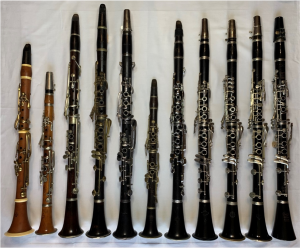
Photo 2: Systems. From left: Müller system (Buffet), Sax (Pelitti), Albert (E. Albert), Boehm (Buffet Jne), Heckel (Heckel), Baermann-Ottensteiner (Osterried Gerlach), Oehler (O. Oehler), Reform Boehm (F. Wurlitzer), McIntyre (McIntyre), Double Boehm (DB), Mazzeo (Selmer).
LS: What other clarinet systems are there in your collection?
AG: In addition to the ancient instruments ranging from five to 13 keys and more (see Photo 1), there are the Müller system, the Sax system, the Albert system, German systems and other more particular ones.
LS: Can you explain them?
AG: The Müller system, as I have already mentioned, has 13 keys. The Sax and Albert systems, slightly different from each other, are similar to the Müller but have in addition two rings for the ring and middle fingers of the right hand. It seems that the first to devise the rings on the clarinet was Adolphe Sax. The Albert system can be found with various extensions in the rings and keys. The German system has a slightly different bore than the French one and develops first as a Baermann-Ottensteiner system, then Stark-Osterried, up to evolving into the Oehler and Schmidt-Kolbe systems.
Subsequently the Reform Boehm was created which was a fusion between the German-bore clarinet and the mechanics of the “reformed” Boehm system with various tricks, as the name of the system suggests. The first to build these tools was Fritz Wurlitzer and I own an instrument of his. They were handcrafted and are now quite rare. In addition to these systems there are a great many experiments and systems that try to improve certain parts of the clarinet. For example, various patents have been made to improve the throat B-flat, which has always been a critical point of the instrument due to its function as a passing note between the low and high register. One of the most interesting systems in this regard is the one invented by the McIntyre brothers in 1959, who were probably inspired by the Romero system, where high keys are suppressed in favor of a system that uses the rings of the left hand. Others are the Mazzeo model, the Leblanc patent of 1933 and the SK mechanism of Prof. Stubbins. Going back in time, there are some hybrids between the various systems, that is, tools that have, for example, the keys of the Boehm system combined with the Albert’s rings, or vice versa. Other systems are Pupeschi, Clinton, Heckel, Graessel, Double Boehm, etc. (see Photo 2).
LS: Which are the most important countries in the historical panorama of the clarinet?
AG: Germany and France. To these we can add Belgium, Italy, England, Austria, the Czech Republic and the United States. Other countries are involved in a more marginal way.
LS: Do you have an example of these less central countries?
AG: To name one, I have a clarinet in C Sax system from Luxembourg branded Guill. Stomps, fournisseur de la Cour, Conservatoire de Luxembourg.
LS: What are the materials used for the construction of clarinets throughout its history?
AG: The materials are varied. Antique clarinets are typically made of boxwood, a very compact light wood, suitable for making musical instruments. The tree of this wood has a very slow growth and after the massive use made in the first half of the 19th century it began to be scarce. Thus, ebony that came from Africa began to be used. At first, ebony was more valuable than boxwood because it came from afar, then over the years it became the usual material. After the great exploitation of this wood, some types of ebony are now at risk of extinction. So, in modern times, some have started using wood pulp in order to reduce waste. Obviously other types of wood such as rosewood, cocobolo, olive, etc. have also been and are used. In ancient times, for a few more valuable specimens, ivory was also used.
At the beginning of the 19th century, the use of metal began, the use of which intensified in the first half of the 20th century, especially in the United States. After the Second World War, metal had become less available and a new material appeared on the market that from then on would invade the world, not just the clarinet: plastic. I own one of the first examples made with this new material, the 1953 Grafton in yellow plastic. This brand had a moment of notoriety with the saxophone played by Charlie Parker. After the project failed, better luck was tried with the clarinet but unfortunately this too was unsuccessful. In the second half of the 19th century, ebonite was also used, a material with characteristics similar to wood but cheaper. Kohlert and later Buffet Crampon also produced plexiglass clarinets. In 1984 the Gustav Rudolf Uebel brand produced a futuristic aluminum clarinet, but unfortunately I haven’t found one for my collection yet.
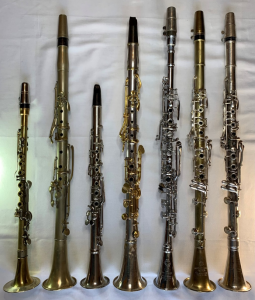
Photo 3: Metal clarinets. From left: Schemmel in E-flat with 7 keys, Crampon in B-flat Müller system with double bore, anonymous in E-flat (attributed to Fritz Mallach) Sax system with double bore, Conn Wonder in B-flat Albert system with double bore, Hawkes & Son in Bí Albert system with plates in 4 holes, Penzel Müller Clari-Met in B-flat Boehm double bore system, Triebert in B-flat Boehm double bore system.
LS: However, you have several metal clarinets, right?
AG: Yes, I have some interesting specimens, like a seven-key Vienna Shemmel dated around 1830. Then I have a Kohlert and a Hawkes & Son from the early 20th century. However, the finest metal clarinets are the double-chambered ones. In my collection there is a clarinet attributed to Rampone di Milano with the Müller system from around 1880, one of the first double-bore clarinets built in Italy. Then I have three Conn Wonders in E-flat, C and B-flat, the first double-bore instruments made in the United States around 1890. With the Boehm system there are a Clari-Met Penzel Müller from 1910 and a Triebert, also from the early 20th century (see Photo 3).
LS: What variety of instrument sizes or keys do you have?
AG: I will give some examples for each starting from the smallest: I have a sopranino in A-flat Rampone and Cazzani. Then clarinets in G (Wolf), in F (Uhlmann), in E (Wrede, Horn), in E-flat (Bratti and Ballerini, Huttl, Pfaff, Schaller), in D (Berthold, Stengel), in D-flat (Stowasser), in C (Amlingue, Gerock & Wolf, Huller, Ludwig & Martinka, Martin Fres, Noblet ainè), in B (Daniel, Lefevre, Mahillon), in B-flat (Barfoot, Cerveny), in A (Schemmel) (see Photo 4). Then there are alto clarinets (Evette & Schaeffer, Orsi), bass (Sioli, Hawkes & Son) and a double bass in E-flat, a Leblanc (see Photo 6). On some instruments the instrumental key is not always clear. Instruments in certain periods could be made with higher pitch (High Pitch) or lower pitch (Low Pitch), and if the instrument does not have the original mouthpiece, sometimes the tone can be confused with a high or low pitch. Furthermore, in history the intonation has been variable depending on the period and the area. So, for example, clarinets that look like B might actually be B-flat with high pitch.
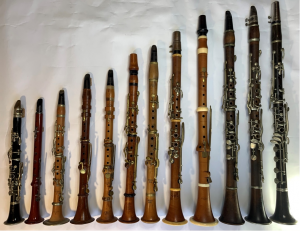
Photo 4: Small clarinets, sopraninos and sopranos. From left: Rampone and Cazzani in A-flat, Wolf in G, Uhlmann in F, Eulry in E, Brambach in E-flat, Kruspe in D, Stowasser in D-flat, Thibouville fils in C, Goulding in B, Kulow in Sib, Jerhing in A, Maino & Orsi in B-flat descending to E-flat.
LS: Are there two-tone clarinets?
AG: In past times, spare parts were used to play in various tones, so there are complete sets of instruments with spare parts to play for example in C, B-flat and A. I have a Finke with spare parts, including the barrel, in B-flat and A. Then various mechanisms were invented to obtain two or even three tones from a single instrument, as in the case of a Triebert patent from the mid-19th century. In my collection I have a rare Maino & Orsi. From 1881 this factory developed a two-tone clarinet which was very successful, and until 1887 proposed three versions. Mine belongs to the first generation; it is of light wood with a metal inner tube that runs through most of the instrument (see Photo 5).
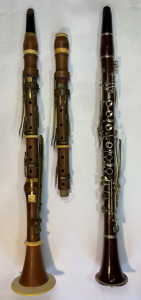
Photo 5: From left: Finke in B-flat with spare part in A, Maino & Orsi double tone B-flat/A.
LS: Are there more recurring names in your collection?
AG: Yes. The Albert family is present with the progenitor Eugène, from whom the Albert system takes its name. Then there are the sons Eugène Joseph and Jacques. Another name of which I have several examples is Buffet. Besides the aforementioned Buffet Jne, there are other clarinets such as a Müller system by Jean Luis before it became Buffet Crampon. Then the brands that temporarily acquired the Buffet Crampon brand are also interesting while maintaining the original brand and allowing Buffet Crampon to continue to exist to this day. These include a Tournier & Goumas clarinet, who administered the Buffet Crampon from 1855 to 1859, and two Evette & Schaeffer specimens from the period from 1885 to 1929. One is an alto clarinet and the other is a rare very compact bass model, through a complete turn on itself of the upper part and a long bell (see Photo 6). Another recurring name is Thibouville. I have some, but the various members of the family and above all the numerous collaborations with other manufacturers make this name count in history in over 25 brands.
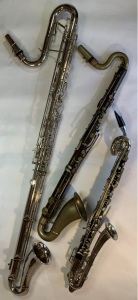
Photo 6: From left: Contrabass clarinet in E-flat Leblanc, bass clarinet Jaques Albert, bass clarinet Evette & Schaeffer (Buffet Crampon).
LS: I guess there are also some curiosities.
AG: I have a left-handed clarinet, i.e. with the fingering reversed – the left hand is at the bottom. It is an Adler; this company was one of the few, or perhaps the only one, that built these instruments in series. A particular instrument is the “strengthened voice” clarinet, Rampone patent from 1900, which is a soprano clarinet with a curved metal bell and barrel. The instrument was later also produced by various French and U.S. brands. Another curiosity is the Clarola from around 1930 from Chicago, a toy with a mechanism similar to mechanical wind-crank organs, which uses rolls of paper with 16 sounds. Finally, something more recent, a Vito (Leblanc) with alternating black and white pieces. It was probably used in U.S. marching bands (see Photo 7).
LS: What does it mean for you to maintain this collection?
AG: Beyond the purely playful aspect that I have always had since I was young, since I collected fossils or bottles of beer, there is certainly an aspect of research and study. Collecting instruments has allowed me to deepen the history and evolution of the clarinet and obviously when possible I try to play the instruments so as to give them new life. I was able to investigate issues about which I knew almost nothing before, such as the history of the metal clarinet or the epic of the Buffet family. Each new instrument I acquire, therefore, provides information and research ideas that contribute to creating a clearer panorama on the history of the clarinet.
LS: I thank Andrea for granting me this interview and for showing me his collection live; despite the restrictions due to the pandemic we were able to spend an entire day together and I was able to touch almost all the tools in his collection which, I hope will also become a teaching aid and traveling exhibition to be combined with appropriate master classes on the history and evolution of our instrument.
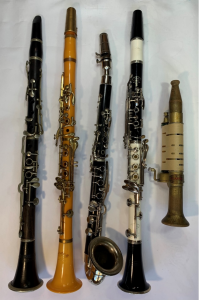
Photo 7: From left: left-handed Adler, Grafton,
Rampone & Cazzani “with a reinforced voice,”
Vito, Clarola.
About the Writer
Luca Saracca is chair of international relations for the ICA and professor of clarinet at the Conservatory of Music “Francesco Morlacchi” in Perugia, Italy. He was born in Perugia where he studied clarinet at the conservatory under the guidance of Ciro Scarponi, and later studied at the Salzburg Mozarteum Akademie with Alfred Prinz (Vienna Philarmonic). He has performed on clarinet and basset horn throughout Europe and the U.S. with many chamber music ensembles and orchestras including the Orchestra Filarmonica Marchigiana and Namaste Clarinet Quartet. Saracca plays Herbert Wurlitzer Reform Boehm clarinets.
Comments are closed.